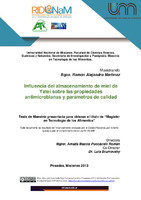Influencia del almacenamiento de miel de Yateí sobre las propiedades antimicrobianas y parámetros de calidad
Abstract
Tetragonisca angustula, es una abeja de la subfamilia Meliponidae conocida tradicionalmente como Yateí. Su miel se diferencia de la miel producida por Apis mellifera por ser menos viscosa, más ácida, poseer dulzura y aromas particulares, además, a esta miel se atribuyen cualidades antimicrobianas, por lo que en la provincia de Misiones aumenta permanentemente el número de productores que la comercializan.
Debido a las características diferenciales que presenta esta miel respecto de la Apis mellifera
Es importante conocer su comportamiento en diferentes condiciones de almacenamiento, a los fines de conservar las características de la miel y asegurar el producto como inocuo.
El objeto del trabajo fue determinar la influencia de la temperatura, tipo de envase y tiempo de almacenamiento de la miel de Yateí sobre las propiedades antimicrobianas, parámetros de calidad microbiana y fisicoquímicos como el pH, Hidroximetilfurfural, contenido de humedad, acidez y contenido de diastasa.
El melado se realizó por escurrimiento natural y con jeringas. La metodología utilizada para las determinaciones microbiológicas y fisicoquímicas está basada en el Código Alimentario Argentino (CAA) y en la International Commission on Microbiological Specifications for Foods (ICMSF). Las propiedades antimicrobianas se evaluaron por metodología de difusión en agar Mueller Hinton.
El efecto antimicrobiano ha sido variable según las cepas estudiadas del género Staphylococcus aureus; en tanto, los recuentos microbiológicos hallados resultaron por sobre los estándares normativos vigentes durante las primeras etapas del proceso de conservación, especialmente los recuentos de Mohos y levaduras (> a 102 UFC/g). Los parámetros fisicoquímicos con variaciones más significativas fueron la acidez (to: 42,5 meq acido/kg miel), contenido de humedad (to: 26 %). La temperatura de conservación es un factor que incide en la calidad de la miel, siendo la temperatura de refrigeración la más adecuada a los fines de mantener estándares cercanos a los de miel de Apis mellifera y evitar los efectos de la fermentación característica de este tipo de miel; en cambio la temperatura ambiente es mejor para mantener el poder antimicrobiano frente a algunos microorganismos. No se encontró diferencia significativa entre envases de conservación de plásticos versus vidrio. Tetragonisca angustula is a subfamily Melipon idae bee traditionally known as "Yatei". ItsYours honey is unlike honey produced by Apis mellifera to be less viscous, more acidic, and having a particular sweetness and aromas, also antimicrobial are attributed to this honey attributed to this honey antimicrobial qualities, so that in the province of Misiones it permanently increases the number of producers in the market.
Due to the different characteristics presented inon this honey of Apis mellifera it is important to understand its characteristic? their behavior under different storage conditions, in order to preserve the characteristics of honey and ensure the product as safe.
The objective was to determine the influence of temperature, type of ackaging and storage time on Yateí honey’s antimicrobial properties, microbial quality and physicochemical parameters such as pHsuch as pH and physicochemical, hydroxymethylfurfural (HMF) moisture content, acidity and diastase content.
The syrup wasis made by natural runoff and with syringes. The methodology used for microbiological and physicochemical determinations are based on the Argentine Food Code (CAA) and the International Commission on Microbiological Specifications for Foods (ICMSF). The antimicrobial properties were evaluated by Mueller Hinton agar diffusion methodology.
The objective was to determine the influence of temperature, type of packaging and storage time on Yateí honey’s antimicrobial properties, microbial quality and physicochemical parameters such as pHsuch as pH and physicochemical, hydroxymethylfurfural (HMF) moisture content, acidity and diastase content.
The syrup wasis made by natural runoff and with syringes. The methodology used for microbiological and physicochemical determinations are based on the Argentine Food Code (CAA) and the International Commission on Microbiological Specifications for Foods (ICMSF). The antimicrobial properties were evaluated by Mueller Hinton agar diffusion methodology.
The antimicrobial effect was variable according to the strains of Staphylococcus aureus, meanwhile, microbiological counts were found above regulatory standards in effect during the early stages of the conservation process, especially mold and yeast counts (> 102 CFU/g). The physicochemical parameters with significant variations were heartburn (to: 42.5 meq acid/kg honey), and moisture content (to 26 %). The sStorage temperature is a factor that affects the quality of the honey. The cooling temperature is being most suitable tofor the purposes of maintaining standards close to those of Apis melliferahoney and avoid the effects of the fermentation characteristic of this type of honey, whereas the room temperature is best to maintain antimicrobial power against some microorganisms. No significant difference was found between plastic containers versus glass conservation.
Collections
- Maestría [55]
The following license files are associated with this item:




